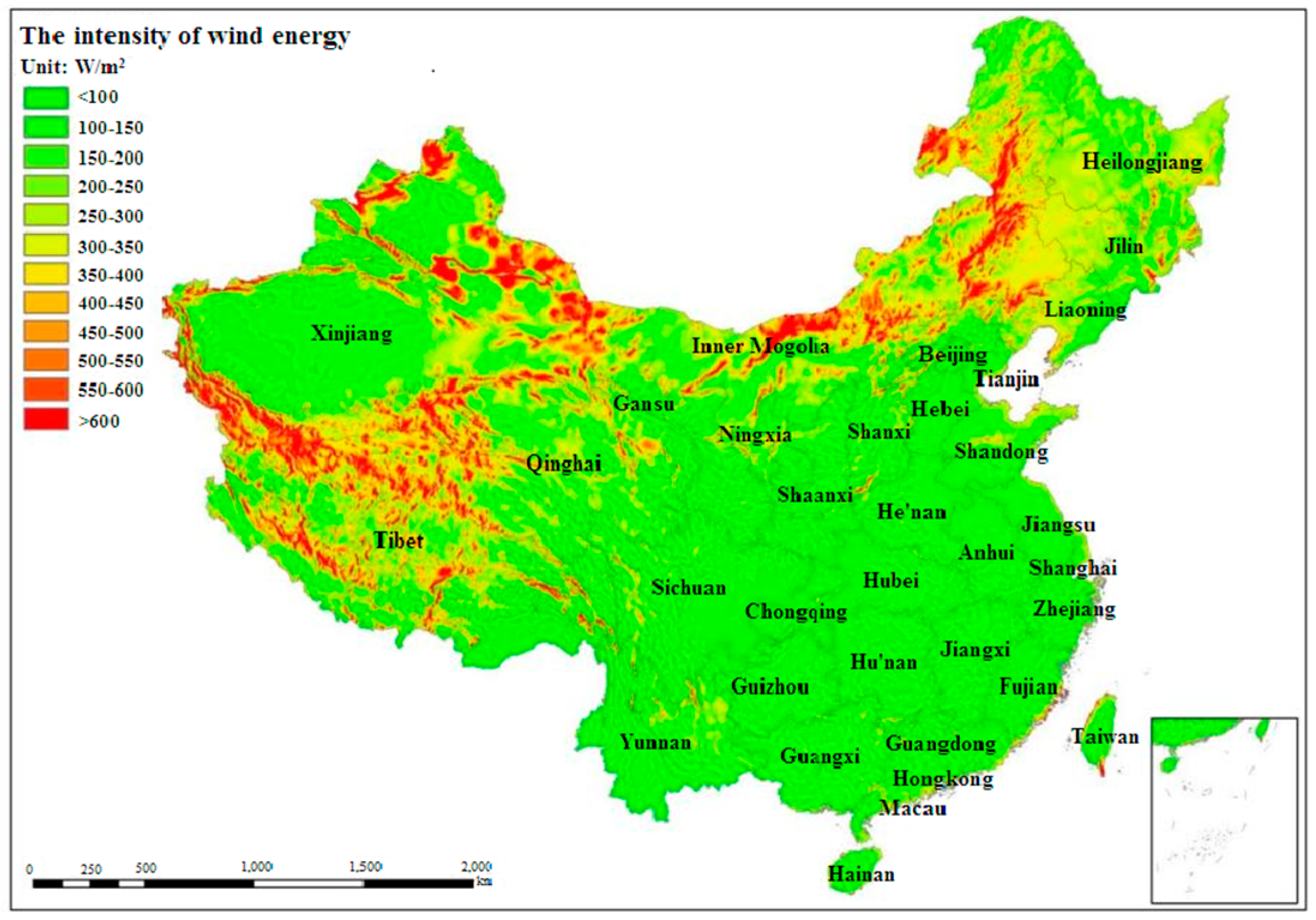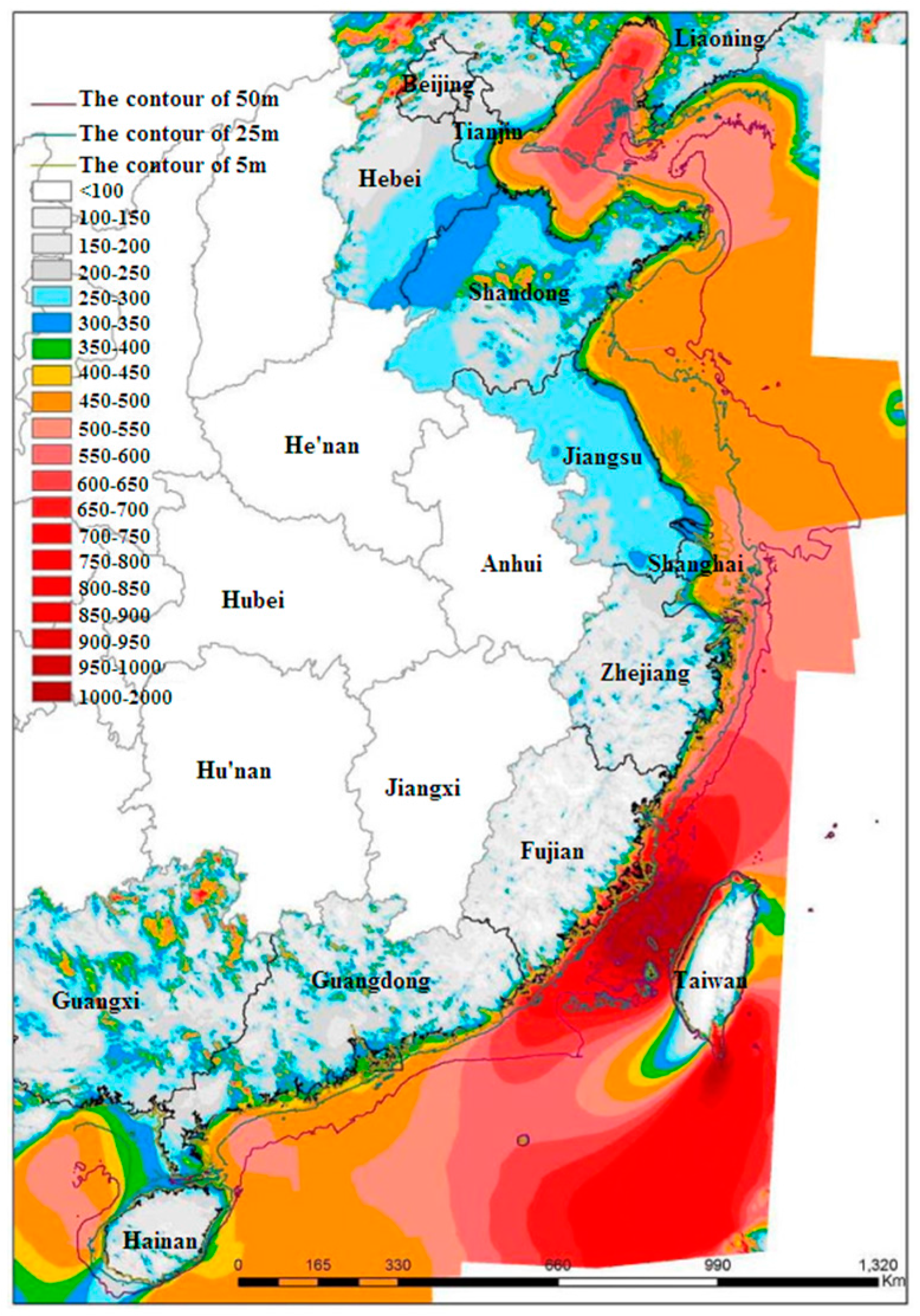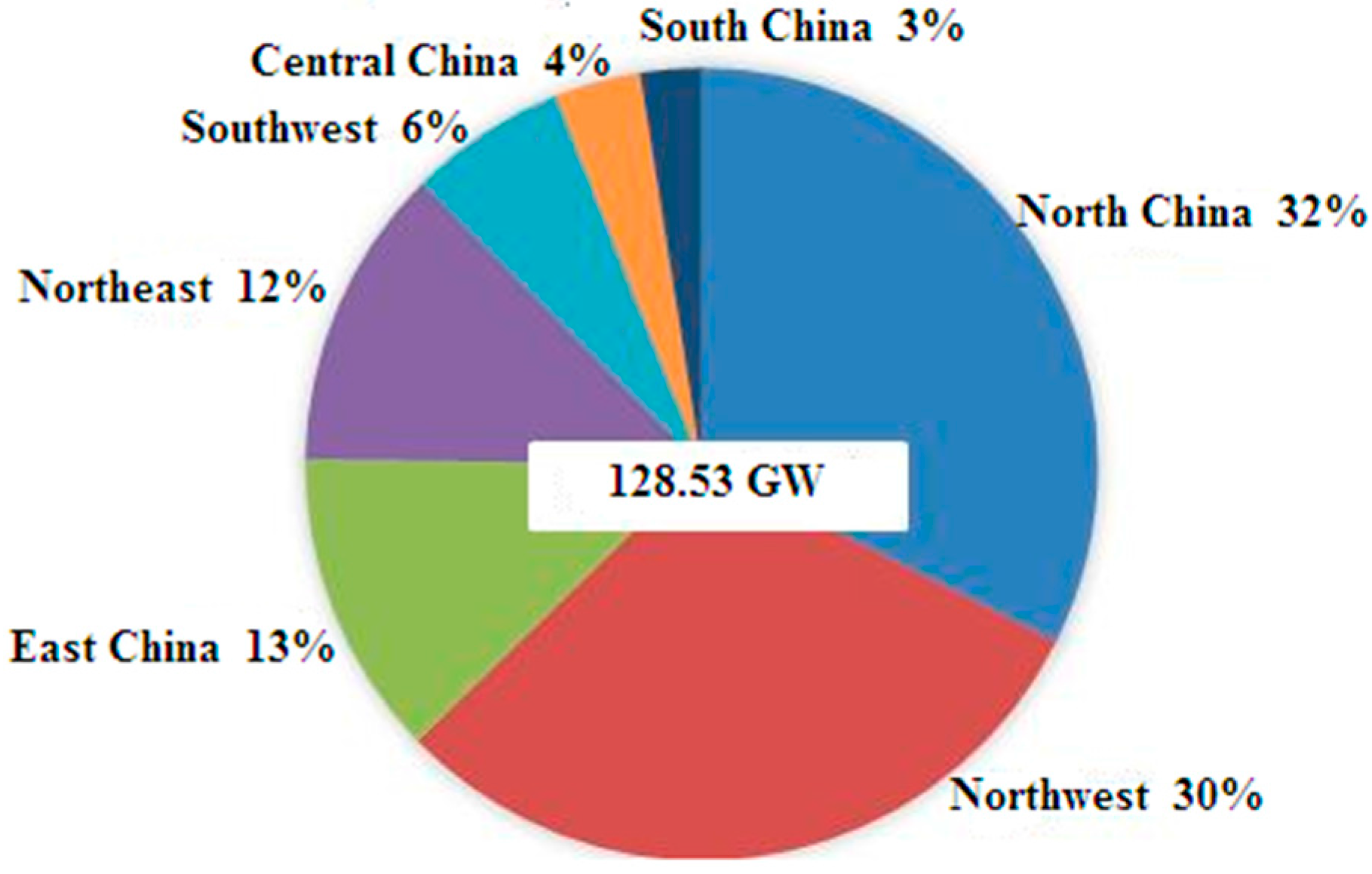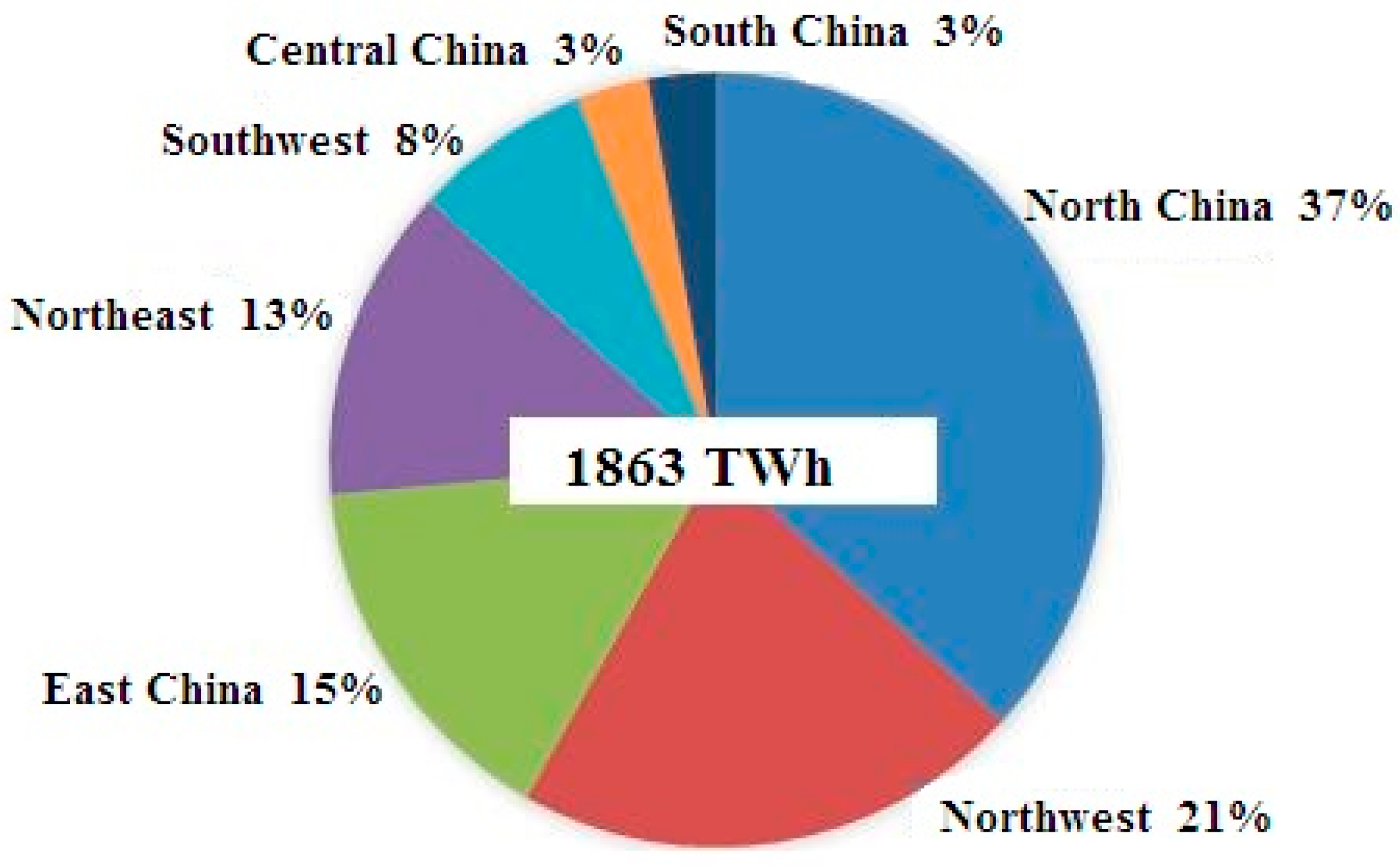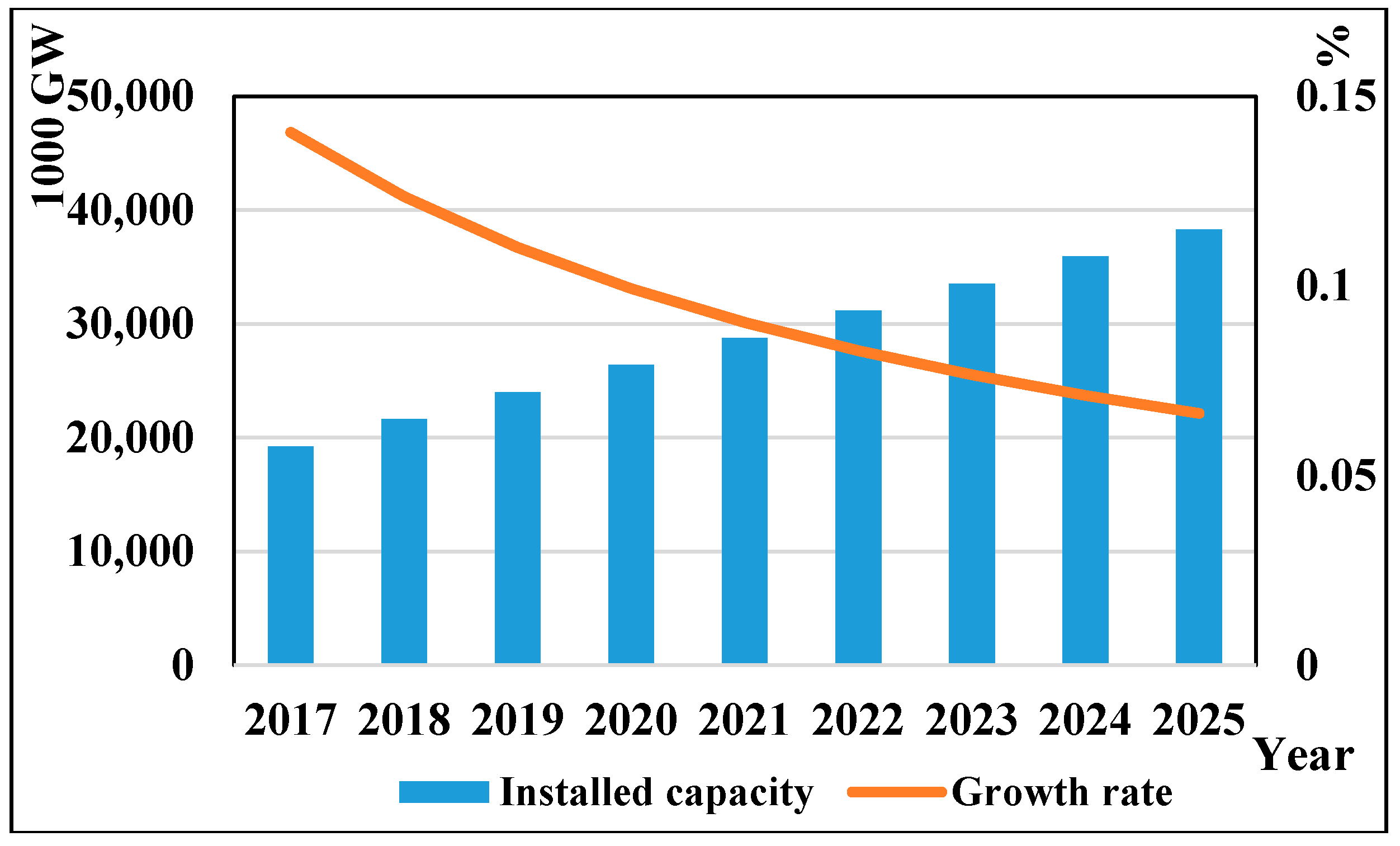1. Introduction
According to the “5th Assessment Report of the Intergovernmental Panel on Climate Change (IPCC)”, the atmospheric concentration of CO
2 increased 40% from the concentration before industrialization, which reached 391 mg/L by 2011 [
1]. In addition, China created 12.3% of the world’s total GDP, consumed approximately 22.4% of the world’s primary energy and contributed 27.1% of the world’s carbon emissions in 2013 [
2,
3]. Under this situation, China has become the largest emitter and energy consumer all over the world, which forces China to face more and more pressure to control its CO
2 emissions and adjust its energy structure [
3,
4,
5,
6,
7,
8]. Therefore, China is making great efforts to achieve sustainable development. For example, China and the United States unveiled a negotiated deal to reduce their greenhouse gas emissions in 2014. In the meantime, China promised a peak in CO
2 emissions by around 2030, intending to increase its share of non-fossil fuels in primary energy consumption to around 20% [
9,
10].
With regard to the environmental problems and fossil-based material’s depletion, alternative non-fossil energies are in urgent need of sustainable development [
11,
12,
13,
14,
15]. Nuclear energy, wind energy, solar energy, hydro-energy, bio-energy, hydrogen energy are considered promising energies in the future that contribute greatly to realizing sustainable development on energy and environment [
16]. Among these renewable energies, wind energy used for power generation is popular in China because of its mature technology, low cost and environmentally friendly characteristic [
17].
It is advantageous for China to develop wind energy for many reasons [
8]. Firstly, due to the abundant onshore and offshore wind energy resources in China, there is a solid foundation for the wind power development. The total wind power energy technically exploitable (with the wind power density over 150 W/m
2) is estimated to be 1400 GW onshore (at 50 m height) and 600 GW offshore by the United Nations Environment Programme (UNEP) [
18]. Now, China has ranked first in cumulative installed capacity with the total capacity of 75.32 GW, taking up 27% of the global sum [
19]. Secondly, China is able to develop wind energy on a large-scale. The Chinese wind power industry has experienced a period of rapid development for the past 10 years [
20] and makes China the major wind energy market in the world now and tomorrow. Wind power has played an important role in power sources with 2.6%, which is only less than the share of thermal and hydro powers until 2012 [
17,
21]. Finally, deployment of wind energy can bring great benefits for environmental protection and energy conservation [
8]. The Chinese government has identified wind energy as a promising and sustainable energy to alter the traditional fuel. There is research that points out the GHG emissions per KWh caused by wind power are as low as 8–20 g, which is just 2.2% of the emissions generated by coal [
22,
23,
24].
Since wind power generation is a sustainable and clean source of energy with environmentally friendly production using green and renewable power [
25,
26,
27,
28,
29,
30,
31,
32,
33,
34], it is essential and necessary to promote the development of wind energy in China to solve the conflict between the energy depletion and environmental pollution. Furthermore, it requires comprehensive insight into the status and the future of wind energy in order to realize the sustainable development of energy, environment and economy in China as well as provide a reference for Chinese policy makers. In addition, there are many methods to predict wind power from different perspectives [
35,
36,
37,
38], such as SWOT analysis (including the analysis of strength, weakness, opportunity and threaten) [
39] and logistic model [
40]. In addition, the advanced hybrid evolutionary of computational intelligence is also applied for wind power prediction [
41]. In this paper, the present situation in China of wind energy distribution, wind power generation and the environmental benefits are studied from the spatial perspective. Furthermore, the installed capacity in the future are predicted by the GM(1,1) model and scenario analysis. In addition, the related problems and recommendations on wind energy are proposed for sustainable development.
The rest of this paper is structured as follows: the status of wind power development in China is presented in
Section 2;
Section 3 focuses on the installed capacity in the future using the GM(1,1) model and scenario analysis; the conclusions and suggestions are shown in
Section 4.
3. Forecasting the Wind Power in China
In this paper, the GM(1,1) and the scenario analysis method are employed to forecast the wind power in China from 2017 to 2025, and the evaluation of the two approaches is presented at the same time.
3.1. GM(1,1) Model
Firstly, it is essential to test the validity of grey model according to the whitening differential equation [
46]. By the calculation on primary data, it is obvious to find that the absolute value of the development coefficient for grey model is greater than 2 and its negative value is less than 0.3; thus, the grey model is suitable for the long-term prediction [
48]. In addition, there is a hypothesis that the condition of economy and the government policy in China in the future is stable enough to make certain the accuracy of the prediction with GM(1,1).
Through the initial data processing such as extracting, taking logarithms or smoothing, a non-negative sequence
X(0) is gained. Then, its Accumulating Generation Operational Sequence and GM(1,1) model is obtained [
49,
50,
51]. Finally, installed capacity in China from 2017 to 2025 is predicted by its time response sequence.
In this paper, the data of installed capacity during 2006 to 2016 is employed as primary information for the prediction. Then, all of the prediction results are shown in
Table 5. Meanwhile, the residual analysis is adopted in order to test the model, and it concludes that the results predicted are reliable.
3.2. Scenario Analysis
Here, the installed capacity is predicted with three scenarios as shown in
Table 6. The GDP growth rate is considered as an indicator for the installed capacity prediction in China from 2017 to 2025, and the installed capacity is predicted as shown in
Table 7.
3.3. Data
The data of installed capacity in China from 2006 to 2016 is collected from National Energy Administration [
43].
3.4. Results and Discussion
With the GM(1,1), the prediction of installed capacity is presented in
Table 5 and
Figure 7. It is obvious to find that the installed capacity in China is increasing from year to year with an average annual growth rate of 9.56% from 2017 to 2025. Furthermore, there has a stable slowdown in the growth rate while the value of installed capacity is increasing. In addition, the installed capacity is stable in an approximate liner tendency as shown in
Figure 7. It could apparently be concluded that the installed capacity in China is projected to reach 38,311.1810 × 10
3 GW after about 10 years, which is roughly 2.27 times than that in 2016. The potential of the wind power development in China is great and the government should pay more attention to it.
With the scenario analysis, it is clear to find that the installed capacity in the future is related to the GDP growth rate closely. When the GDP growth rate is high, the installed capacity in China will reach 40,000 × 103 GW in 2025, while it will be 29,000 × 103 GW under the low GDP growth rate. In addition, it can be concluded that the installed capacity in China from 2017 to 2025 is increasing under all scenarios. Thus, paying more attention to wind power is a prior and essential task for policy makers and academic researchers.
Comparing the two approaches, it is apparent to observe that the predicted results with GM(1,1) are consistent with the results with high scenario analysis approximately due to the data limitation. Because it takes quantitative analysis, qualitative analysis, subjective factors and various possible situations together into account for prediction, the scenario analysis method has a better predictive effect than other prediction methods such as trend extrapolation method and GM(1,1).
4. Conclusions
This paper offers a detailed and comprehensive description for the current status and the development of the wind power in China.
Firstly, now the wind energy in China is majorly distributed in the North region with 2500–3000 GW and the offshore wind energy in Southeast is abundant, which should be exploited effectively in the future. The seven wind power bases are introduced and the Inner Mongolia base located in North China not only makes a great contribution to wind power but also has great wind power potential with 1300 GW installed capacity. In addition, the growth rate of installed capacity and wind power generation in China is declining with 100% in 2006 to 30% in 2015, 107% in 2009 to 17% in 2015, while the absolute value of installed capacity and wind power generation is soaring. Furthermore, the “three North” region makes a great contribution to current installed capacity and wind power generation with 74% and 71%, respectively. It can be seen that China has a solid foundation for the development of wind power. Furthermore, wind energy as a renewable and green energy has significant environmental benefits including the reduction of coal, CO2 and SO2 with 23,887 × 104 tce, 66,854 × 104 tone and 173 × 104 tone in total from 2008 to 2015, respectively, which facilitate sustainable energy and sustainable environment.
Secondly, the installed capacity is predicted by GM(1,1) and scenario analysis. It draws that the annual average growth rate of installed capacity from 2017 to 2025 is 9.56% and the installed capacity of 38,311.1810 × 104 GW in 2025 with GM(1,1). Meanwhile, the installed capacity will reach up to 40,000 × 103 GW in 2025 under the high GDP growth rate and 29,000 × 103 GW in 2025 under the low GDP growth rate with the scenario analysis. It is clear to find that the results predicted by the GM(1,1) model are consistent with that of the high GDP growth rate.
In addition, wind energy as a renewable and clean energy has a significant effect on the sustainable development of economy, energy and environment. Thus, the government in China should stimulate its development widely and effectively by carrying out effective policies and encouraging firms to enhance the technological innovative ability. Although some factors hinder the wind power deployment such as material used in wind turbines and the wind power curtailment problems, the booming development tendency of wind energy will not change under the serious threatening of traditional energy depletion and environmental problems.
Finally, although some valuable information has been reached in this paper, there are still several points that can be improved such as another more precise method employed for the prediction of installed capacity, the influence of technological development, detailed wind power problems and so on. These aspects will be improved in further studies.
